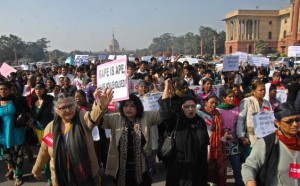New Delhi Rape one year later: 5 lessons about preventing sexual violence

What has changed one year after a 23 year old women was brutally raped in New Delhi? There are articles highlighting the changes and lack of progress. Move to End Violence‘s Movement Makers just returned from a recent visit to India.
Last year I wrote a blog on five lessons for preventing sexual violence after this rape. Do you think there are other lessons we need to learn in order to prevent sexual violence?
1. Rape is a problem everywhere (not only in India) In a Letter to the Editor to the New York Times, Quinnipiac University professor of anthropology Hilary Haldane critiqued editorial and opinion pieces that had noted that while “India has terribly high rates of sexual assault and other forms of violence against women, they do not mention the fact that violence is a global epidemic, not solely a byproduct of Indian culture. Our similarly high rates of sexual assault and other forms of gender-based violence in American culture seem to be accepted by a collective shrug and a ‘blame the victim’ mentality.“ Recent studies like the National Intimate Partner Sexual Violence Survey (nearly 1 in 2 women (44.6%) and 1 in 5 men (22.2%) experience sexual violence throughout their lifetime) demonstrate the pervasiveness of sexual violence in this country. The rape in India reminds us that we need to take action everywhere.
2. Silent No More The rape prevention movement of the 1970s started with Speak Outs Against Rape where survivors came forward with their stories in order to imagine a world where people would not have to experience rape. Earlier this week Jyoti Singh’s father thought the same as he stated in an interview with the Mirror News:
We want the world to know her real name. My daughter didn’t do anything wrong, she died while protecting herself. I am proud of her. Revealing her name will give courage to other women who have survived these attacks. They will find strength from my daughter.
Speaking out is a catalyst for change. Let’s listen to those voices and move to advancing solutions.
3. Bystanders need to make a difference News reports describe how it took hours for someone to intervene in the Delhi gang rape. The bystander approach recognizes that anyone (and indeed everyone) can be part of the solution. Let’s figure out how to find ways to create a culture where it is expected that people will interrupt not only situations of violence and abuse, but also intervene in situations that contribute to the environment that makes rape acceptable.
4. Remix Manhood Preventing rape is tied to transforming the dominant forms of masculinity that celebrate men’s sexual conquest of women into healthy forms of masculinity that respects women and value men taking action to prevent men’s violence against women. It is not only in India that we see the concept of masculinity support an environment that is unsafe for women. It time to do more than “engage men” – we have to expect men to take action to create change.
5. Collective action is powerful In Hilary Haldane’s editorial she states “We could learn from the Indian response to the recent horrific death of a young medical student: collective action and demands for change.” There are many recent examples of primarily women (with some men) working together to build a movement. For example SlutWalks demonstrate outrage over a victim blaming statement from a police officer and Hollaback gives voice to demands to prevent street harassment. Now there are thousands of people in the streets in India working to create change. On February 14, 2013 many of us joined One Billion Rising against rape and domestic violence. The momentum of that action, rallies in India, and other protests can set the stage for creating the changes in our society necessary to end violence.
Photo: Sushil Kumar Verma, The Hindu, (Link to original photo.)

Thank you for this article, I think these are all excellent points. Regarding #1, I agree it is important to recognize that sexual violence is a worldwide problem and not just a byproduct of Indian culture.
I would take it further to say that we should not only call attention to SV in our own society, but also clearly name the issue of white, middle class westerners using examples of violence against women in other cultures as a way to “other” these cultures and dehumanize men of color as inherently violent. Although the case here is from India, we obviously see this in the US with the legacy of the stereotype of African American men as “black brutes” (http://en.wikipedia.org/wiki/Black_brute).
Attitudes such as these contribute to a climate that justifies the marginalization of communities of color, which also increases the vulnerability and limits supportive resources for women and girls in these communities (see Dr. Beth Richie’s book “Arrested Justice” http://chicagogirltalk.wordpress.com/2012/06/01/dr-beth-richie-speaks-about-her-new-book-arrested-justice-black-women-violence-and-americans-prison-nation/). We cannot end sexual and domestic violence without also ending racism and other forms of oppression.
[…] New Delhi Rape one year later: 5 lessons about preventing sexual … http://www.preventconnect.org/I look forward to the reports from my CALCASA colleague Denice Labertew who is returning from a 10 day trip meeting with student activists about responding to gender based violence. … Rape is a problem everywhere (not only in India) In a Letter to the Editor to the New York Times, Quinnipiac University professor of anthropology Hilary Haldane critiqued editorial and opinion pieces that had noted that while “India has terribly high rates of sexual assault and other … […]